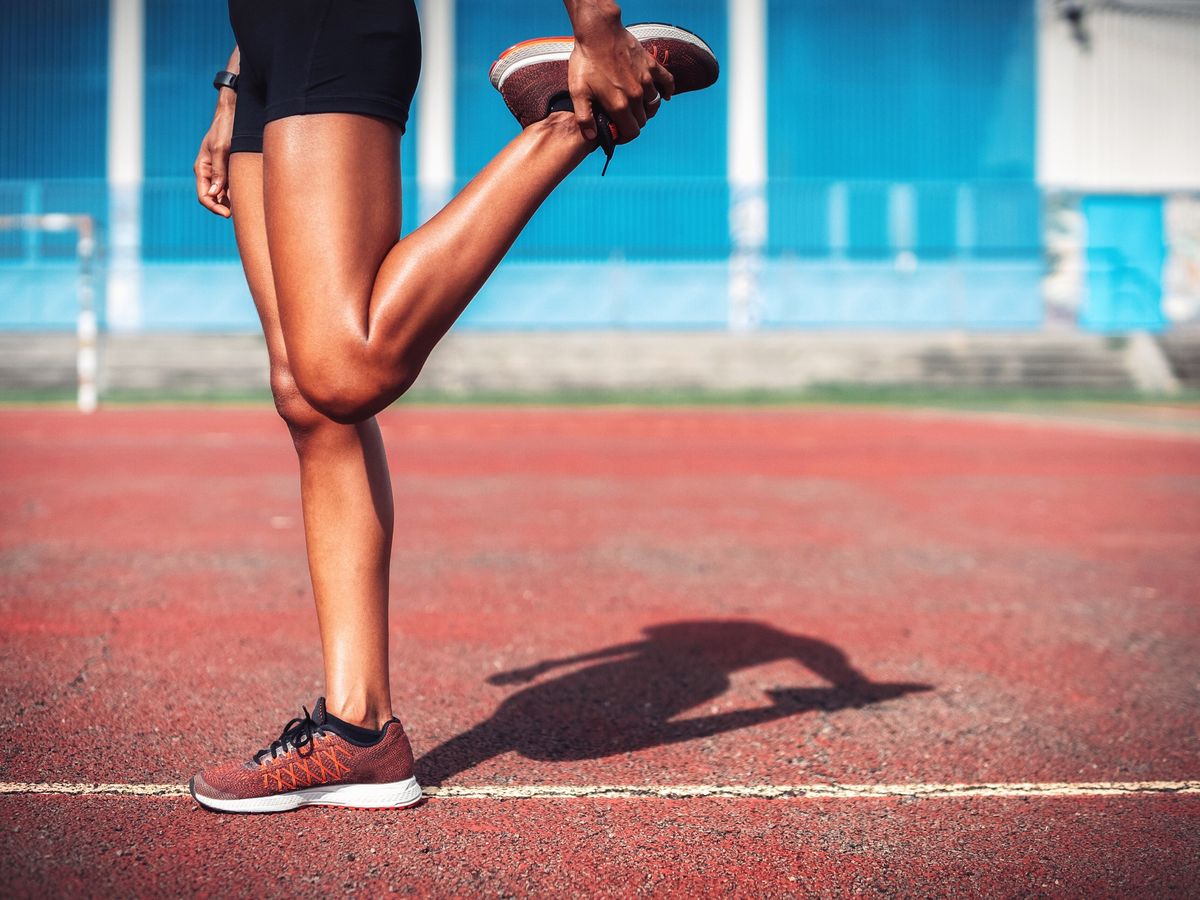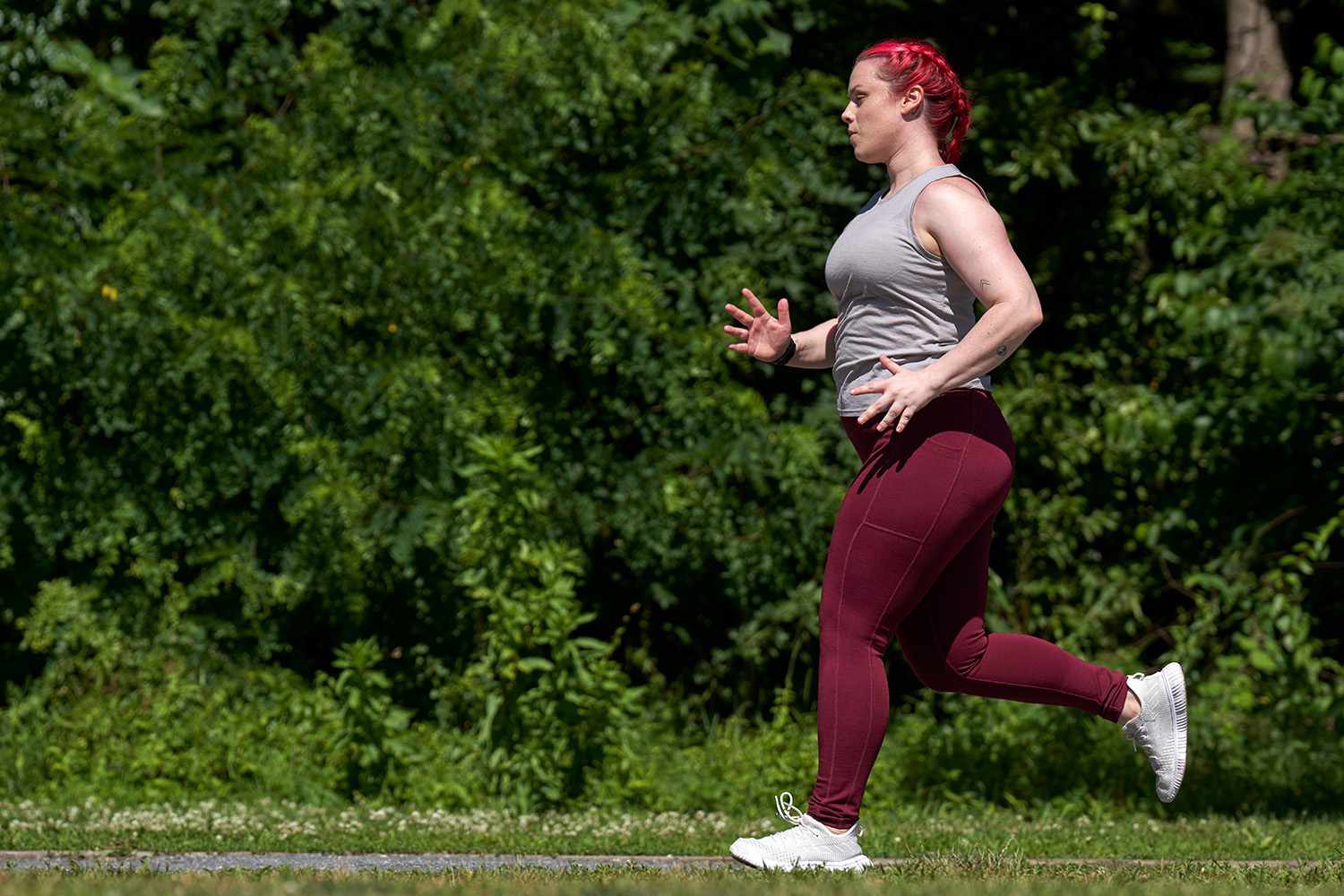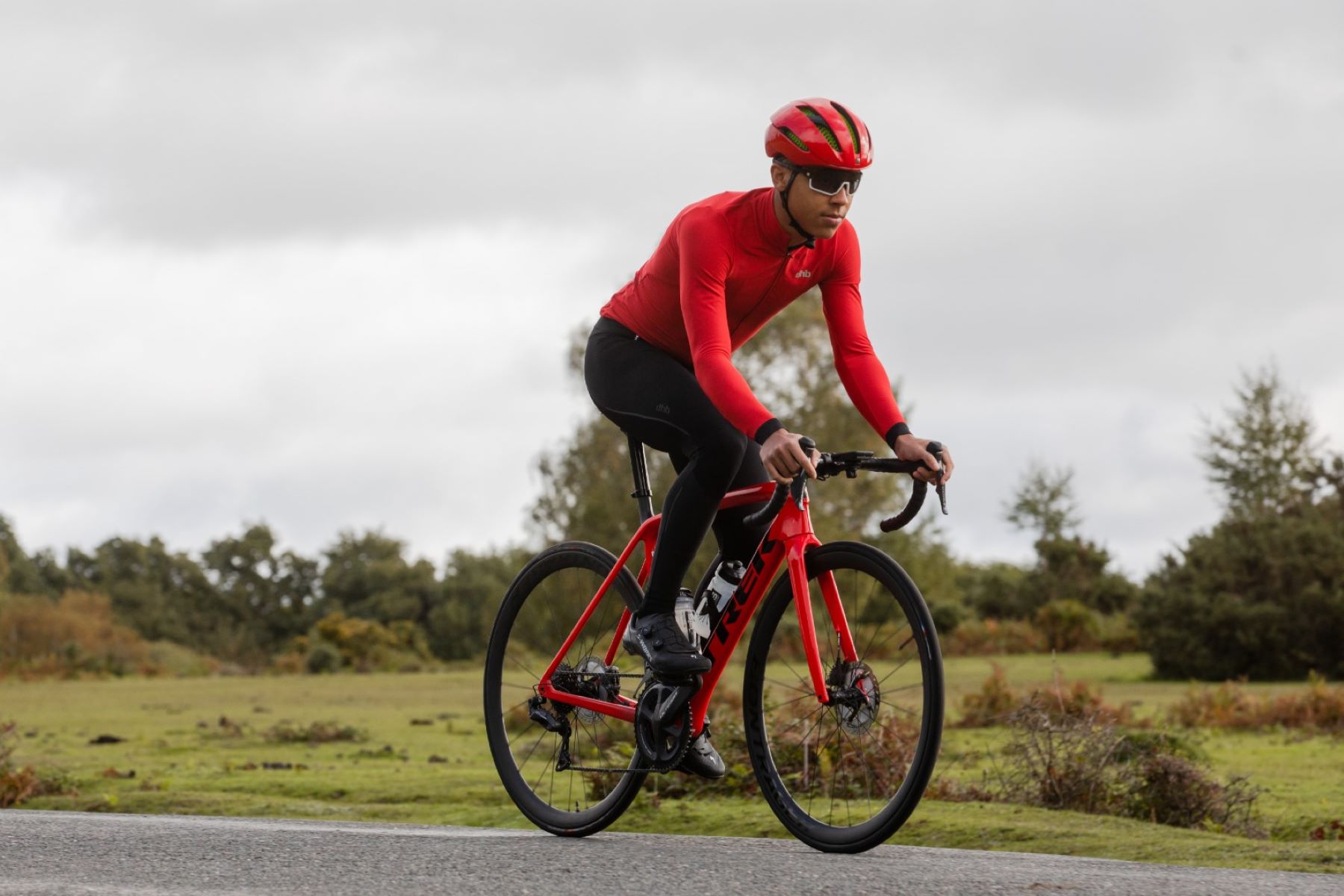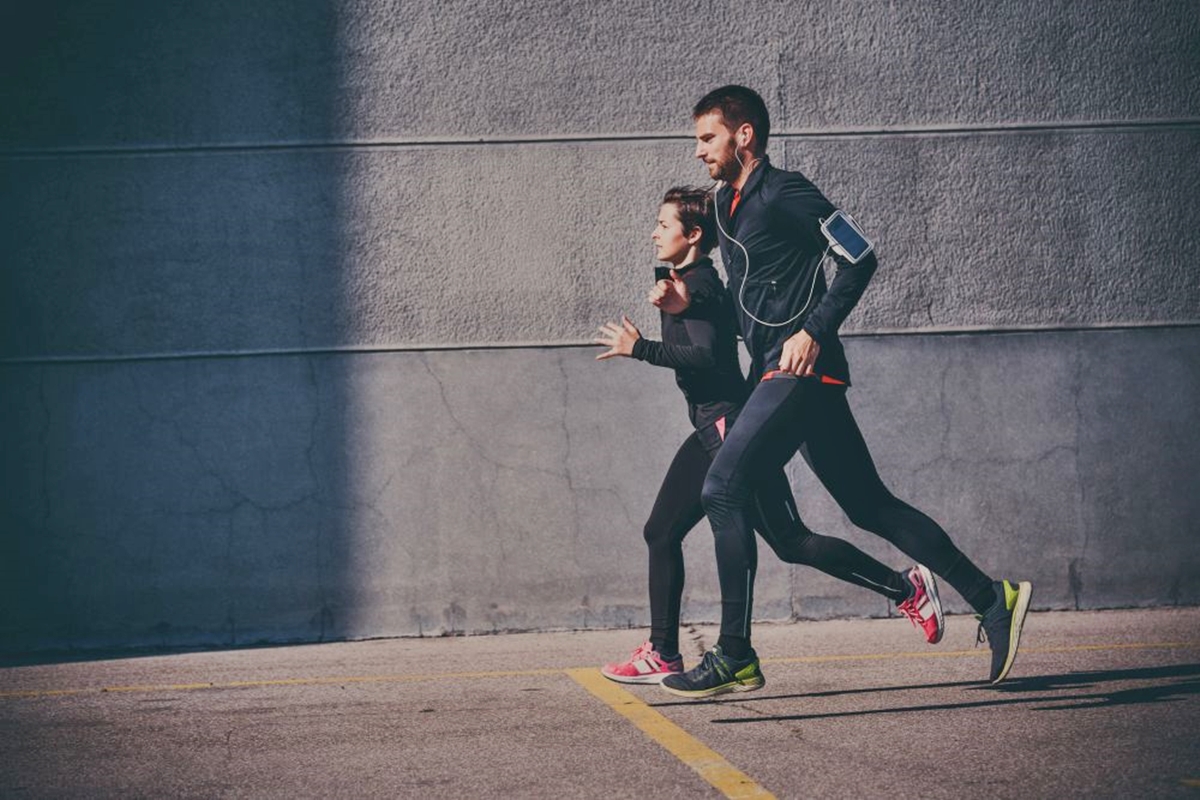Home>Misc>Featured>How To Build Up Legs For Long Distance Running


Featured
How To Build Up Legs For Long Distance Running
Modified: August 21, 2023
Learn the best exercises and training techniques to build strong legs for long distance running. Our featured guide will help you reach your running goals.
Introduction
When it comes to long distance running, having strong legs is crucial for success. Whether you’re training for a marathon, a half-marathon, or simply want to improve your endurance, building up your leg strength is essential. Not only will strong legs help you handle the physical demands of long distance running, but they will also improve your overall performance and reduce the risk of injuries.
Building up your leg muscles through targeted exercises will not only make you a more powerful runner but also enhance your overall speed and endurance. Additionally, strong legs provide the foundation for proper running form and help with maintaining efficiency throughout your runs.
Understanding the anatomy of your legs is the first step towards building them up for long distance running. The legs consist of several major muscle groups, including the quadriceps, hamstrings, calves, and glutes. Each of these muscle groups plays a unique role in your running mechanics and should be targeted through specific exercises.
In this article, we will explore the importance of leg strength for long distance running and provide you with a comprehensive guide on how to build up your leg muscles effectively. From choosing the right exercises to incorporating resistance training and plyometrics into your routine, we will cover everything you need to know to take your running to the next level.
So let’s dive in and discover the best exercises and training strategies to build up your legs for long distance running!
Importance of Leg Strength for Long Distance Running
Having strong leg muscles is vital for long distance running. Your legs are responsible for generating the power and endurance needed to propel you forward mile after mile. Here are some key reasons why leg strength is crucial for long distance runners:
- Improved Performance: Strong legs allow you to produce more force with each stride, enabling you to run faster and maintain a consistent pace throughout your runs.
- Enhanced Endurance: Building up your leg muscles helps delay the onset of fatigue, allowing you to run longer distances without feeling as tired.
- Reduced Risk of Injury: Weak leg muscles can lead to imbalances and poor running mechanics, increasing the risk of overuse injuries such as shin splints, stress fractures, and IT band syndrome. Strengthening your legs can help prevent these injuries and improve overall stability.
- Improved Running Form: Strong leg muscles provide a solid base and help maintain proper alignment during your runs. This improves your running form and reduces the risk of inefficient movement patterns that can waste energy.
- Increased Stability: Leg strength enhances the stability of your joints, particularly the knees and ankles. This stability is crucial for navigating uneven surfaces, running downhill, and absorbing impact during your runs.
- Efficient Running Mechanics: Strong leg muscles help you maintain efficient running mechanics and reduce wasted motion, leading to improved overall running economy.
By focusing on building up your leg strength, you can enhance your running performance, increase your endurance, and reduce the likelihood of injuries. The next section will delve into the specifics of the leg muscles and exercises that target them.
Understanding the Anatomy of the Legs
Before diving into the exercises to build up your leg muscles, it’s important to have a basic understanding of the anatomy of the legs. The legs are composed of several major muscle groups that work together to facilitate movement and provide stability. Here are the key muscle groups involved in leg strength for long distance running:
- Quadriceps: Located at the front of the thigh, the quadriceps consist of four muscles: the rectus femoris, vastus lateralis, vastus medialis, and vastus intermedius. The quadriceps are responsible for extending the knee and are heavily engaged during the push-off phase of running.
- Hamstrings: Situated at the back of the thigh, the hamstrings comprise three muscles: the biceps femoris, semitendinosus, and semimembranosus. The hamstrings are involved in knee flexion and hip extension and act as stabilizers during the swing phase of running.
- Calf Muscles: The calf muscles, specifically the gastrocnemius and soleus, are located in the lower leg. These muscles play a vital role in ankle plantar flexion, which propels you forward during running.
- Glutes: The gluteus maximus and gluteus medius are the main muscles in the buttocks area. These muscles provide power and stability during locomotion and are essential for maintaining proper running form.
Understanding the role of each muscle group is crucial in targeting them effectively during your training. By developing strength and endurance in these muscles, you can optimize your running performance and reduce the risk of injuries.
In the next section, we will explore the different exercises that specifically target these muscle groups, helping you build up your leg strength for long distance running.
Choosing the Right Exercises
When it comes to building up your leg strength for long distance running, it’s important to choose exercises that target the specific muscle groups involved in running. Here are some key considerations to keep in mind when selecting the right exercises:
- Functional Movements: Opt for exercises that mimic the movements you make during running, such as squats and lunges. These exercises engage multiple muscle groups and help improve overall running mechanics.
- Compound Exercises: Compound exercises involve movements at multiple joints, allowing you to engage more muscles simultaneously. Examples include squats, lunges, and step-ups. These exercises are efficient and effective for building leg strength.
- Bilateral and Unilateral Exercises: Incorporate both bilateral exercises (using both legs simultaneously) and unilateral exercises (working one leg at a time) into your routine. Unilateral exercises help identify and correct any strength imbalances between the legs.
- Plyometric Exercises: Plyometric exercises, such as box jumps and explosive bounding, are valuable for developing explosive power that translates to faster running speed. These exercises also improve your muscle’s ability to absorb and generate force rapidly.
- Hill Training: Running hills is an excellent way to build leg strength and endurance. The incline forces your leg muscles to work harder and adapt to the demands of uphill running.
It’s important to note that the exercises you choose should be appropriate for your current fitness level and take into account any existing injuries or limitations. Consider working with a fitness professional or trainer who can guide you in selecting the right exercises and ensure proper form and technique.
Now that we’ve covered the factors to consider when choosing exercises, let’s explore the specific leg exercises recommended for long-distance running in the next section.
Recommended Leg Exercises for Long Distance Running
When it comes to building up leg strength for long distance running, incorporating a variety of exercises into your training routine is key. Here are some recommended leg exercises that target the major muscle groups involved in running:
- Squats: Squats are a fundamental exercise that targets the quadriceps, hamstrings, and glutes. Start with bodyweight squats and gradually progress to weighted squats for added resistance.
- Lunges: Lunges are a unilateral exercise that focuses on quadriceps, hamstrings, and glutes. Perform walking lunges or stationary lunges with proper form to strengthen each leg individually.
- Calf Raises: Calf raises specifically target the calf muscles, which play a crucial role in ankle plantar flexion during running. Perform calf raises using bodyweight or add resistance by using dumbbells or a calf raise machine.
- Step-ups: Step-ups are a compound exercise that engages the glutes, quadriceps, and hamstrings. Use a bench or a step platform to step up and down, alternating legs.
- Leg Press: Leg press machines provide a controlled and targeted workout for the quadriceps and hamstrings. Adjust the machine to your comfort level and focus on proper form throughout the movement.
These exercises should form the foundation of your leg strength training routine. Aim to perform two to three sets of each exercise with eight to twelve repetitions per set. As you progress, gradually increase the weight or resistance to continue challenging your muscles.
In addition to these exercises, incorporating plyometric exercises into your routine can help develop explosive power. Jumping exercises like box jumps, squat jumps, and single-leg hops can enhance your muscular strength and speed.
Remember, it’s important to prioritize proper form and technique during these exercises to maximize their benefits and reduce the risk of injury. If you’re new to strength training, consider working with a fitness professional or trainer to ensure correct execution.
Now that you have a range of exercises to choose from, let’s explore how to incorporate resistance training and plyometrics into your running routine in the next section.
Squats
Squats are a highly effective exercise for building leg strength and are a staple in any long distance runner’s training routine. They primarily target the quadriceps, hamstrings, and glutes, which are crucial for generating power and stability during running.
Here’s how to perform squats with proper form:
- Stand with your feet shoulder-width apart, toes slightly turned out.
- Engage your core and keep your chest lifted throughout the movement.
- As you lower your body, push your hips back as if you are sitting into an imaginary chair.
- Continue descending until your thighs are parallel to the ground or slightly below.
- Keep your knees in line with your toes, ensuring they don’t collapse inward.
- Pause for a brief moment, then exhale and push through your heels to return to the starting position.
It’s important to start with proper form and gradually increase the weight or resistance as you become more comfortable and stronger. You can perform squats using just your bodyweight or gradually add dumbbells or a barbell for added resistance.
Variations of squats, such as goblet squats or front squats, can also be incorporated to target the leg muscles from different angles and challenge your muscles in new ways. Additionally, performing squats on an unstable surface, like a Bosu ball, can further engage your core and challenge your balance.
When performing squats, it’s crucial to prioritize your form over the amount of weight you lift. Maintaining proper form ensures that you engage the correct muscles and reduce the risk of injury. If you’re unsure about your form, consider working with a fitness professional or trainer to receive guidance and feedback.
Incorporating squats into your leg strength training routine will help develop the necessary muscle strength and power to improve your long distance running performance.
Lunges
Lunges are a highly effective exercise for building leg strength and improving stability, making them a valuable addition to any long distance runner’s training routine. They primarily target the quadriceps, hamstrings, and glutes, helping to improve power, endurance, and balance.
Here’s how to perform lunges with proper form:
- Start by standing upright with your feet hip-width apart.
- Take a step forward with your right foot, ensuring that your knee is directly above your ankle.
- Lower your body by flexing your right knee and hip, keeping your left knee bent and your left heel lifted.
- Descend until your right thigh is parallel to the ground, or your knee is at a 90-degree angle.
- Pause for a moment and then push through your right heel to return to the starting position.
- Repeat the movement on the other leg by stepping forward with your left foot.
As you perform lunges, maintain an upright posture and keep your core engaged for stability. It’s essential to keep your front knee in line with your toes to prevent any excessive stress on the knee joint. You can start with bodyweight lunges and gradually increase the difficulty by holding dumbbells or using a barbell across your shoulders.
Additionally, there are variations of lunges that you can incorporate to target the leg muscles in different ways. For example, reverse lunges involve stepping backward instead of forward, placing more emphasis on the hamstrings. Walking lunges involve taking consecutive steps forward, which helps improve coordination and balance.
Unilateral exercises like lunges are particularly valuable for runners because they help identify and address any strength imbalances between the legs. By performing lunges, you can strengthen each leg individually, ensuring symmetry and reducing the risk of injuries.
Remember to focus on maintaining proper form and alignment throughout each lunge. If you have any concerns or are new to this exercise, consider consulting with a fitness professional to ensure proper execution, gain personalized guidance, and receive feedback on your technique.
By incorporating lunges into your leg strength training routine, you can improve your running performance, increase stability, and enhance your overall lower body strength.
Calf Raises
Calf raises are a valuable exercise for strengthening and developing the calf muscles, which play a crucial role in generating power and propulsion during running. Strong calves contribute to improved speed, stability, and overall lower leg strength.
Here’s how to perform calf raises with proper form:
- Stand with your feet hip-width apart and ensure your body is in an upright position.
- Place the balls of your feet on the edge of a step, allowing your heels to hang off the edge.
- Engage your core and keep your body steady throughout the exercise.
- Rise up onto your toes by pushing through the balls of your feet. Lift your heels as high as you can while maintaining balance and control.
- Hold the raised position briefly and then slowly lower your heels back down below the step, feeling a stretch in your calf muscles.
- Repeat the movement for the recommended number of repetitions.
You can perform calf raises using your body weight alone, or for added resistance, you can hold dumbbells or use a calf raise machine at the gym.
It’s important to emphasize controlled movements and a full range of motion during calf raises. Avoid bouncing or using momentum to get through the exercise. Focus on the contraction and squeeze of your calf muscles as you rise onto your toes.
Additionally, you have the option to vary your foot position during calf raises to target different areas of the calf muscles. By performing calf raises with your toes turned slightly inward or outward, you can target specific parts of the calf muscles for a well-rounded workout.
Strong calves not only enhance running performance but also provide stability and support to the ankle joint, reducing the risk of injuries such as ankle sprains. By incorporating calf raises into your leg strength training routine, you can build endurance and improve the overall strength of your lower legs, which is essential for long distance running.
Step-ups
Step-ups are an effective exercise for building leg strength and stability, making them a valuable addition to your long distance running training routine. This compound exercise primarily targets the quadriceps, hamstrings, and glutes, helping to improve power, endurance, and balance.
Here’s how to perform step-ups with proper form:
- Stand facing a box, step, or platform that is knee-height or slightly higher.
- Place one foot firmly on the step, driving your weight through your heel.
- Engage your core and step up onto the platform, ensuring your knee is directly above your ankle.
- Push through your heel to lift your body up, fully extending your hip and knee.
- Pause briefly at the top and then lower yourself back down, maintaining control.
- Repeat the movement on the same leg for the desired number of repetitions before switching to the other leg.
As you perform step-ups, keep your chest lifted and avoid leaning forward. Focus on engaging the muscles of your elevated leg while maintaining proper alignment in your hips, knees, and ankles.
You can start with bodyweight step-ups and progress by adding resistance, such as holding dumbbells or wearing a weighted vest. Additionally, increasing the height of the step or using a single-leg variation can further challenge your muscles and enhance balance and stability.
Step-ups are an excellent exercise for developing single-leg strength, which is beneficial for runners as it helps improve stability and prevent muscle imbalances. By working each leg individually, you can identify and address any weaknesses, reducing the risk of injuries and promoting symmetrical muscle development.
Incorporating step-ups into your leg strengthening routine can help enhance your running performance by improving leg power, stability, and overall lower body strength.
Leg Press
The leg press is a popular exercise for targeting the quadriceps, hamstrings, and glutes, making it an effective addition to your leg strength training routine for long distance running. The leg press machine allows you to lift heavier weights safely and provides a controlled environment for working your lower body muscles.
Here’s how to perform the leg press with proper form:
- Adjust the seat of the leg press machine so that your knees align with your hips.
- Place your feet shoulder-width apart on the footplate, ensuring your knees are pointing in the same direction as your toes.
- Grasp the handles or side supports of the machine for stability.
- Release the safeties and slowly lower the weight by bending your knees, keeping your heels on the footplate.
- Descend until your knees are bent to about a 90-degree angle, or slightly lower if comfortable.
- Push through your heels, extending your legs and straightening your knees to return to the starting position.
Focus on maintaining control throughout the movement and avoid locking your knees at the top of the press. Keep your back flat against the seat and engage your core for stability.
The leg press machine offers versatility as you can adjust the weight and foot placement to target different muscle groups. Placing your feet high on the footplate emphasizes the glutes and hamstrings, while placing them lower targets the quadriceps. Experiment with different foot positions to find what works best for your training goals.
When incorporating the leg press into your routine, start with lighter weights and gradually increase the resistance as your strength improves. Aim for two to three sets of eight to twelve repetitions, focusing on maintaining proper form and control throughout each repetition.
The leg press is an excellent exercise for building leg strength and muscle endurance, which are essential for long distance running. It allows you to safely and effectively target the major muscle groups in your lower body, helping to improve power, stability, and overall running performance.
Plyometric Exercises for Explosive Power
Plyometric exercises are a fantastic way to improve your explosive power and enhance your running performance. These exercises involve quick, powerful movements that engage your muscles to generate maximum force in a short amount of time. Plyometrics can help you develop speed, agility, and the ability to generate explosive energy during your runs.
Here are a few plyometric exercises that are particularly beneficial for long distance runners:
- Box Jumps: Start by standing in front of a sturdy box or platform. Bend your knees, swing your arms back, and explosively jump onto the box, landing softly with your knees slightly bent. Step down with control and repeat for the desired number of repetitions.
- Jump Squats: Begin in a squat position with your feet shoulder-width apart. Explosively jump up, extending your arms overhead, and land softly back into the squat position. Repeat for the recommended number of repetitions.
- Bounding: Bounding involves leaping forward with an exaggerated stride, focusing on generating maximal power and distance with each leap. Alternate legs as you bound forward, emphasizing a quick and explosive push-off.
- Single-Leg Hops: Stand on one leg and hop forward, backward, or laterally. Focus on maintaining stability and explosiveness. Switch to the other leg and repeat the hops for balance and symmetrical training.
- Squat Jumps: Start in a squat position with your feet shoulder-width apart. Propel yourself upward with an explosive jump, reaching for maximum height. Land softly back into the squat position and repeat.
When performing plyometric exercises, it’s crucial to pay attention to your landing mechanics to avoid injury. Land with soft knees, focus on landing on the balls of your feet, and absorb the impact through your muscles rather than your joints.
It’s essential to gradually incorporate plyometric exercises into your training routine to allow your body to adapt and prevent overexertion or injury. Start with a few repetitions and gradually increase both intensity and volume over time.
Plyometric exercises are an excellent way to develop explosive power, which can translate into improved running speed, efficiency, and performance. Incorporate these exercises into your training regimen to take your long distance running to the next level.
Hill Training for Leg Strength and Endurance
Hill training is a challenging yet highly effective method for building leg strength, endurance, and overall running performance. Incorporating hill workouts into your training routine can help you develop the necessary strength and power to tackle inclines with ease and improve your overall running efficiency.
Here are the key benefits of hill training for leg strength and endurance:
- Increased Muscle Engagement: Running uphill forces your leg muscles, including the quadriceps, hamstrings, and glutes, to work harder than on flat terrain. This increased muscle engagement helps build strength and endurance in these key muscle groups.
- Improved Cardiovascular Fitness: Running uphill elevates your heart rate and challenges your cardiovascular system. Over time, this improves your overall cardiovascular fitness, enhancing your ability to sustain higher intensities and longer distances during your runs.
- Enhanced Running Form: Uphill running forces you to adopt a more efficient running form, with shorter strides and increased knee lift. This improved form can carry over to flat running and help you become a more efficient runner overall.
- Increased Mental Resilience: Conquering challenging hills during training builds mental toughness and resilience. It teaches you to push through discomfort and persevere, which can be invaluable during long distance races and challenging runs.
When incorporating hill training into your routine, start gradually by finding a moderate incline that challenges you without overwhelming you. Begin with shorter distances or time intervals and gradually increase the duration and intensity as your strength and endurance improve.
Focus on maintaining an upright posture, leaning slightly forward from the ankles, and driving your arms to propel yourself uphill. Shorten your stride and take quick, powerful steps to maintain momentum and engage your leg muscles effectively.
Remember to balance your hill training with adequate rest and recovery, as the intensity of these workouts can put significant stress on your muscles and joints. Varying the incline, duration, and frequency of your hill workouts can help avoid overuse injuries and allow for proper adaptation.
By incorporating hill training into your routine, you’ll build both leg strength and endurance, enabling you to tackle challenging terrains and elevate your long distance running performance.
Incorporating Resistance Training into Your Running Routine
Resistance training is a valuable addition to your running routine as it helps build overall strength, improve muscular endurance, and enhance performance. By incorporating regular resistance training sessions into your training regimen, you can target specific muscle groups, prevent imbalances, and reduce the risk of injuries.
Here are some key considerations when incorporating resistance training into your running routine:
- Balance and specificity: When designing your resistance training program, aim for a balance between targeting major muscle groups involved in running and addressing any individual weaknesses or imbalances you may have. Prioritize functional exercises that mimic the movements and demands of running.
- Focus on core stability: A strong core is essential for maintaining good running form and providing stability and support for your entire body. Incorporate exercises like planks, Russian twists, and bridges to strengthen and stabilize your core muscles.
- Progressive overload: Gradually increase the intensity, resistance, or weight used in your resistance training exercises over time to continue challenging your muscles. This progressive overload stimulates muscle growth and strength gains.
- Frequency and recovery: Aim to perform resistance training exercises 2-3 times per week, allowing for adequate recovery between sessions. This frequency allows your muscles to adapt and grow stronger while minimizing the risk of overtraining.
- Variety of exercises: Incorporate a variety of resistance training exercises to target different muscle groups and prevent boredom. Include exercises such as squats, lunges, deadlifts, rows, and overhead presses to work your entire body.
- Full range of motion: Perform resistance exercises through their full range of motion to maximize muscle engagement and flexibility. This also helps improve joint mobility and reduces the risk of muscle imbalances or restricted movements.
It’s important to note that resistance training should complement your running routine rather than detract from it. Avoid scheduling intense leg workouts right before a long run or race, as it can impact your recovery and running performance. Allow for adequate rest and recovery, and listen to your body’s cues.
You may also consider seeking guidance from a qualified strength and conditioning professional or personal trainer who can help tailor a resistance training program to your specific needs and goals.
By incorporating resistance training into your running routine, you can improve overall strength, prevent injuries, and enhance your running performance. It’s a valuable investment in your long-term running success.
Importance of Proper Form and Technique
When it comes to building leg strength for long distance running, proper form and technique are absolutely essential. Paying attention to how you perform each exercise and ensuring correct execution is crucial for maximizing results and reducing the risk of injuries. Here’s why proper form and technique are so important:
- Muscle Activation: Performing exercises with proper form ensures that the targeted muscles are activated and engaged effectively. It allows you to optimize the recruitment of the desired muscle groups, leading to better overall muscle development and strength gains.
- Efficiency: Proper form helps you perform exercises efficiently, allowing you to get the most out of each movement. By executing exercises with the correct range of motion and alignment, you can enhance muscle coordination and movement efficiency, which translates to more efficient running mechanics.
- Injury Prevention: Using proper form and technique significantly reduces the risk of injury. It helps maintain proper joint alignment, reduces unnecessary stress on joints, and prevents strain or overuse of muscles. When muscles, tendons, and ligaments are aligned and working harmoniously, the risk of overuse injuries or acute injuries is minimized.
- Balance and Stability: Proper form promotes better balance and stability during exercises, which improves overall control and reduces the risk of falls or accidents. This is particularly important for exercises that involve single-leg movements, as balance and stability are crucial for preventing injuries and maintaining proper form.
- Targeted Training: By maintaining proper form, you can ensure that the intended muscle groups are being targeted effectively. This is crucial for achieving balanced muscle development and addressing weaknesses or imbalances that may impact your running performance.
To ensure proper form and technique, it’s vital to understand the correct alignment, range of motion, and body positioning for each exercise. Take the time to learn and practice proper form for each movement, and focus on engaging the targeted muscles throughout the entire exercise.
If you’re new to strength training or unsure about your form, consider working with a fitness professional, physical therapist, or coach who can provide guidance, feedback, and corrections. They can help ensure that you are executing the exercises properly and help you avoid any potential mistakes that could hinder your progress or lead to injury.
Remember, quality always trumps quantity when it comes to strength training. Prioritize proper form and technique, and always listen to your body. By doing so, you can maximize the benefits of your leg strength exercises and optimize your long distance running performance.
Common Mistakes to Avoid
When it comes to building leg strength for long distance running, it’s important to be mindful of potential mistakes that can hinder your progress or increase the risk of injuries. By being aware of these common mistakes and actively working to avoid them, you can maximize the effectiveness of your workouts and ensure your safety. Here are some common mistakes to watch out for:
- Poor Exercise Execution: Performing exercises with improper form and technique can compromise their effectiveness and increase the risk of injuries. It’s crucial to learn the correct form for each exercise and focus on executing them with precision.
- Using Too Much Weight: Using excessively heavy weights can lead to compromised form, increased risk of injuries, and limited range of motion. It’s important to start with weights that allow you to perform exercises with proper form and gradually increase the resistance as your strength improves.
- Neglecting Warm-up and Cool-down: Skipping warm-up exercises and cool-down stretches can increase the risk of muscle strains, sprains, and other injuries. Always start your workout with a proper warm-up to prepare your muscles for the upcoming activity and end with a cooldown to help your body recover.
- Overtraining and Insufficient Rest: Pushing yourself too hard and not allowing enough rest between workouts can lead to overtraining, decreased performance, and an increased risk of injuries. Balancing your training load with proper rest and recovery is essential for long-term progress and injury prevention.
- Ignoring Minor Discomfort and Pain: Ignoring minor discomfort or pain can potentially lead to more severe injuries. It’s important to listen to your body and address any signs of pain or discomfort promptly. Seek medical advice if necessary to prevent further complications.
- Not Progressing Gradually: Progressing too quickly or not challenging yourself enough can both be detrimental to your progress. It’s important to find the right balance by gradually increasing the intensity, volume, or resistance of your workouts to continue stimulating your muscles without overwhelming them.
- Forgetting to Breathe: Breathing properly during exercise is often overlooked but is crucial for providing oxygen to your muscles and maintaining a steady rhythm. Remember to breathe in through your nose and out through your mouth, especially during more challenging movements.
Recognizing and avoiding these common mistakes can help you optimize your leg strength training and minimize the risk of injuries. Additionally, seeking guidance from a fitness professional or coach can provide valuable insight and feedback on proper technique, programming, and individualized corrections.
Always prioritize safety, listen to your body, and make adjustments as needed. By doing so, you can effectively build leg strength, improve your running performance, and reduce the likelihood of setbacks during your training.
Tips for Preventing Injuries
Preventing injuries is crucial for maintaining a consistent and successful long distance running routine. Here are some important tips to help you reduce the risk of injuries and stay healthy:
- Listen to Your Body: Pay attention to any signs of discomfort, pain, or fatigue. If something doesn’t feel right, take a break, modify your training, or seek professional guidance to prevent further injury.
- Warm Up Properly: Always start your workout with a proper warm-up to increase blood flow to your muscles, enhance flexibility, and prepare your body for the upcoming activity. Dynamic stretches, light jogging, or mobility exercises are effective warm-up techniques.
- Gradually Increase Intensity: Avoid sudden increases in training intensity or volume, as this can put excessive stress on your muscles and lead to overuse injuries. Gradually progress your workouts to allow your body time to adapt and respond positively to the physical stress.
- Include Rest Days: Rest and recovery are vital for preventing overtraining and reducing the risk of injuries. Incorporate regular rest days into your training schedule to allow your body to repair and rebuild muscle tissue.
- Proper Footwear: Invest in a pair of well-fitting running shoes that provide adequate support and cushioning to minimize impact on your joints and reduce the risk of common running-related injuries.
- Strength Training: Incorporate strength training exercises into your routine to strengthen your leg muscles and improve overall stability. Strong muscles provide better support for your joints and reduce the risk of overuse or improper mechanics during running.
- Cross-Train: Incorporating cross-training activities like cycling or swimming can help reduce the repetitive stress on your legs and provide a well-rounded fitness routine. This can help prevent overuse injuries and provide variation in your exercise regimen.
- Proper Nutrition and Hydration: Fuel your body with a balanced diet to support muscle recovery and overall health. Stay hydrated before, during, and after your runs to maintain optimal performance and prevent cramping.
- Stretch and Cool Down: After each workout, make time for stretching and a proper cool-down. This helps improve flexibility, reduce muscle soreness, and enhance recovery.
Remember that each runner is unique, and what works for one may not work for another. Listen to your body, be mindful of your limitations, and adjust your training accordingly. If you experience persistent pain or discomfort, consult with a healthcare professional to identify the underlying cause and develop a targeted treatment plan.
By incorporating these injury prevention strategies into your long distance running routine, you can maintain a healthy and sustainable training program and enjoy the many benefits of running for years to come.
Conclusion
Building strong legs is essential for long distance running, as it provides the foundation for endurance, speed, and overall performance. The exercises and concepts discussed in this article can help you develop the leg strength and power needed to excel in your running endeavors.
Understanding the anatomy of your legs and targeting specific muscle groups through exercises like squats, lunges, calf raises, step-ups, and leg presses is key to building leg strength. Incorporating plyometric exercises and hill training helps develop explosive power and endurance, while resistance training complements and supports your running routine.
Throughout your training, it’s important to prioritize proper form and technique to maximize effectiveness and reduce the risk of injuries. Avoiding common mistakes, listening to your body, and implementing injury prevention strategies, such as proper warm-up and cool-down, can help you stay strong and healthy on your running journey.
Remember, every runner is unique, so listen to your body, make adjustments as needed, and consult with a fitness professional or coach if necessary. Consistency, gradual progression, and adequate rest and recovery are key to building leg strength and achieving your long distance running goals.
So lace up your shoes, hit the road or trail, and enjoy the process of building up your legs for long distance running. With dedication, proper training, and a focus on strength, you’ll be well on your way to becoming a stronger, faster, and more resilient runner.









